From time to time, every gardener wants to transform his garden plot and add some bright and unusual paints to it. Some choose the most familiar plants of different varieties, others prefer to acquire flowering decorative shrubs, which also look noble in landscape design. And only the true connoisseurs of unusual and ancient colors choose such cultures as a plant acronite - majestic perennials with bright and amazing flowers.
These plants are high perennials whose inflorescences are very similar to Knight's helmets. Regarding the occurrence of the flower of acronite, there are many legends and legends, but not even knowing the rich history of culture, from one look at him it is safe to argue about his unsurpassed beauty. Athonite, landing and care for which is not much different from all other perennial flowering plants, will certainly become one of your favorite flowers.
In this article, consider the peculiarities of growing aconite, as well as a description of the most popular species and varieties of this plant. We give important moments of planting and care for this culture.
Features and description of aconite
Athonite is a perennial herbaceous flowering plant, which belongs to the iltike family, although the external similarities are very insignificant. This plant was known since the times of ancient Greece, which, undoubtedly, empowers the grass acromitis with huge charm and mysteriousness. In nature, this culture is found in Asia, Europe and North America, and more specifically in their temperate zone. Often, this wonderful flower can be found on elevations, on wet meadows and edges, which contains nutritional soil. On the territory of Russia, aconite can sometimes be seen on the side of the roads, on abandoned areas in the villages. A few decades ago, this flower could be found in almost every garden, and from the 16th century, the acronite was actively aggravated at the Klumps of the noble estates.
The word "aconite" has several options for origin. Translated from Greek Aconae translates as a "rock", and the word ACONTion is "arrows." Such definitions are directly related to the appearance of akonite - its blooms really resemble the arrows, and the place of growing this culture is the rocks and rocks.
There are several legends of this unusual flower. For one of them, this flower appeared from the poisonous saliva of the Cerper, which guarded the underground world. In his eleventh feat, Hercules lured this PSA to the surface that the Cherberian ruined. On the spot where saliva fell, poisonous flowers of aconite appeared, the name that the plant received from the city, near which it all happened - akona.
This plant has several more names, among which the most popular wrestler. Related origin with Scandinavian myths. In place, where the ancient God thor fought with snakes and died from their bites, this extraordinary flower appeared with poisonous roots.
Acronite is really a very poisonous plant. His properties as poison were known to the ancient Chinese and Greeks, where with the help of this plant, poisonous arrows were made. She wrote to Plutarchs that the glorious warriors Mark Antonia after hitting them such an arrow lost their minds and rushed with bile.
Aconita description
- Perennial aconite is a herbaceous reprehensive or curly plant, the height of which depends on a particular variety. On average, the height of the straight stem is 30-200 cm, and the height of the climbing can reach even 4 meters.
- Rhizome plants are quite massive, oval form. In length, it can reach 5 cm, and in a width of 2 cm. Long roots depart from it, which in the depth penetrate about 30 cm.
- Depending on the type, the acronite may be both rhizuissed and a coronextly cloth.
- The leaves on the stems are located next and have a bright emerald color. In the form of leaves may be different, it all depends on the type and variety of the plant. Discern the leaves dissected, palphatic-separated and blade.
- The flowering of aconite begins in July and lasts until the end of September.
- Flowers from this plant have an irregular shape. The cup in the form of a funnel consists of 5 cups, the top of which is bent in the form of a knightly helmet.
- All flowers on the flowers are collected in simple or private branching inflorescences, which can be 40-50 cm long.
- Athonite pleases the variety of colors of its inflorescences. Most often there are blue and purple flowers, but there are varieties and purple flowers, yellow, pink, white or motley.
- Herbate plant Acronite for open soil is an optimal culture, as in essence it is rather unpretentious, and not all varieties have a poison component. Even if you plant a poisonous aconite on the site, after a few years of anchored cultivation, all poisonous properties disappear.
- It is necessary to be very careful with a aconite, since this plant is absolutely all parts.
- After biting inflorescence, a multifreeze leaflet appears with a large number of small aconite seeds, which have a rather short period of germination - approximately 1 year.
- When working with young plants, roots and tubers of aconite, always use gloves. And after work wash your hands thoroughly.
The diversity of species and varieties of aconite
Total to date been studied and described about 300 different species of aconite, which have widely different characteristics of appearance characteristics and cultivation as well as growing area. Some species to date are listed as endangered and are on the verge of extinction. Consider the features of the most popular species and varieties of aconite.
Aconitum napellus
- This is the kind of aconite is the most popular and widespread in Russia. He could often be found on our gardens.
- Natural habitat aconite napellus is the area of \u200b\u200bEurope and Asia.
- This plant is a rather large shrubs that formed strong stems and powerful. The plant can reach a height of about 2 meters. Tie those flowers necessarily stems are not afraid of the wind.
- Different sort of fairly long flowering when fades the central part, the flowers appear on the side shoots.
- Flowers dark purple hue.
- This type of aconite is very volatile and is represented by a large number of shapes and smaller species.
The most common species of aconite napellus:
- Aconite napellus compact. This variety blooms pale lilac buds. Plants reach a height of 90-100 cm.
- Aconite napellus lobelievidny. Flowering varieties of Aconite comes in mid-July. Characterized by bright blue inflorescences, sometimes with a blue tint. At the height of the shrub can reach 120-150 cm.
- Aconite napellus Glecherayz. These flowers bloom in early July and please beautiful white inflorescences.
- Aconite napellus pyramidal. Plants of this species reach a height of about 120 cm. Has large flowers of bright purple-blue hue. Flowering begins in July and lasts until August.
aconite paniculata
- The natural habitat of this species of aconite is the area of \u200b\u200bSouthern Europe.
- Bush formed branched stems which may reach a height of 100-150 cm.
- The flowers of this species bloom on long flower stems and collected in a fairly loose brush.
- Seeds are presented with only one wing.
- The flowers are bright blue or blue tint.
Aconite or mottled nosy
- Natural habitat is the area of \u200b\u200bCentral Europe and Russia. Most often, these flowers are found on grassy forest clearings.
- In height, the plant can reach about 2 meters.
- The leaves of this variety dissected and large, color dark green.
- It pleases this variety with large colors of blue, white or blue and white shade.
- Blossom starts in mid-July and ends at the beginning or mid-September.
This type of aconite has several common forms:
- Athonite motley elegant. The plant in height can reach about 100 cm. Different with beautiful colors and carefulness in care.
- Acronite motley shape motley. This type of aconite is very thin stems, so it is necessary to put a support when growing.
- Athonite motley dissected. This species is represented by bright blue-purple inflorescences.
Athonite Cammarum Two-Toleric
- This is a hybrid variety that was removed by breeding a motley shape and blue.
- Plants of this species have the external characteristics of both bodies.
- They differ larger and beautiful colors. Inflorescences are most often two-color.
- It is a very popular species among domestic gardeners.
Several beautiful varieties of Cammarum two-color acronite:
- Grade "Bicolor". Plants of this variety are distinguished by strong branching and rather short inflorescences. Bicolor acronite pleases its bright white-white colors with purple car.
- Grandiflower Album grade. This plant blooms the long brushes of snow-white large colors.
- Grade "Pink Senseishen". Pleases with gentle pink flowers.
Aconite reproduction: the most common ways
Athonite can be seen independently on its site, the main thing you need to know the main nuances of the main ways. For this culture, the following reproduction options are applicable: seed reproduction, shilling, the division of the bush and the reproduction of tubers. Knowing the features of breeding aconite, you can choose for yourself the most suitable and convenient way.
Seed reproduction of aconite
- Seed reproduction is the most time-consuming option, as it requires a lot of time and effort to receive healthy and adult aconite seedlings.
- This method is most often used by breeders for breeding new varieties of culture.
- First of all, the main complexity is that the aconite seeds need a long-term stratification process. If you sow seeds into open ground, it must be done under the winter so that for three frosty months they managed to pass. When sowing seeds to seedlings, the pre-landing material is placed in the huma and put the container in the refrigerator until April.
- In April, prepare containers with nutrient soil under the boarding of aconite. Clean the seeds and well in them.
- In the future, care for seedlings should be in watering.
- When seedlings appear at least 2 leafs, they can be seen in separate containers.
- Grow seedlings during the summer, and in August, transfer them to a permanent place, while keeping the distance between seedlings in 25 cm.
- With seed reproduction, young aconite plants can only be bloated in 2-3 years.
Acronite reproduction by bush
- Once every 4 years, the bustard of aconite needs rejuvenation and mandatory transplant. Therefore, at this time you can proceed with its reproduction, if you have at least one athonite plant at your site. If you do not have, you can ask for acquaintances, because they still need to sear a aconite.
- To divide the acronite bush is best in the early spring, before the start of active vegetation.
- To do this, carefully dig up the bush and divide it with an acute shovel into several parts. Watch that each decene has 2-3 healthy kidneys and full roots.
- After division, immediately put young plants on the place prepared in advance. Watch that the root neck is blocked by about 2-3 cm.
The reproduction of aconite Chenikov
- In this way, you can also dilute aconite yourself. For this you do not need to possess some special skills, it is enough to be attentive and clearly follow the steps.
- To multiply aconite with green cuttings is necessary in May.
- To do this, cut the cuttings of 11-13 cm long aconite with a bustle, while the planting material should be with the heel.
- Before boarding, place all the cuttings into the growth of the growth stimulator or the rooting agent.
- After that, land your seedlings into the prepared soil and cover each plastic bottle or film to create a greenhouse effect and protection against frost.
- When aconite seedlings rooted, they can be planted at a permanent place.
The reproduction of aconite Cornklubnya
- This way is also quite simple can be alone aconite on its site.
- To do this, it is necessary to take several tubers from under the busta in the fall.
- Prepare the planting wells with a depth of approximately 5-7 cm, on the bottom of which you need to pour some fertilizer.
- Place in each well 2-3 tuber and pour the planting material.
Preparation before landing acronite in open ground
Athonite is a rather unpretentious plant, however, it is important for proper cultivation of culture to carefully prepare so that the plant gets strong and beautifully blooming. First of all, take care of the choice of a suitable variety and buy a healthy seedling. If you wish to grow a plant from scratch, plunder seeds in time to obtain a strong seedlings until the landing.
Stage 1. Selection of varieties and aconite seedlings
- Athonite can be of different heights, so pick up a specific variety under a predetermined landing site.
- You can choose varieties of different colors, which will create a very beautiful garden composition. In addition to the blue and purple, standard aconite colors, a large number of varieties with white and yellow inflorescences are currently brought by breeders.
- If you do not want to independently deal with the cultivation of seedlings or seedlings of aconite, ready-made seedlings can be purchased in specialized garden centers and nurseries, which are professionally engaged in breeding plants.
- Before buying, you can ask for consultants about the cultivation of a particular variety of aconite.
- When buying in specialized stores, you get a seedling that is already adapted to the conditions of your climate.
- Carefully inspect the entire seedling before buying. It should not be damage, signs of diseases and presence of pests.
Stage 2. Choosing a place for planting acronite
- The choice of space in the open soil for planting acronite is the most important stage, since this plant is very poisonous and when entering the body can cause an attack of suffocation and paralysis.
- First of all, such a bush should grow in place inaccessible to pets and children.
- Athonite is not demanding for sunlight, so it can grow perfectly in a small shade, for example, under the crown of small garden trees or along high fences. Curly varieties can be used along the wall of the house or plant around the gazebo in the garden.
- Some varieties of aconite prefer to grow on the elevated areas, however, most of themselves can feel great in a slightly moistened location.
Stage 3. Choice and preparation of the soil before planting acronita to outdoor soil
- All varieties of aconite are growing perfectly practically on any types of soil.
- Gardeners do not recommend landing this culture only on heavy stony soils.
- This plant prefers to grow on nutrient and fertile soils. If the soil site chosen is very poor, before boarding the acronite seedlings it is necessary to fasten it well. In this case, the compost or humus is suitable.
- It is not necessary to plant aconite on clay soils, as they delay moisture, and this is detrimental to culture. To make such a soil suitable for landing seedlings, just add a little sand at the landing site.
- Before boarding the soil section, you choose a thoroughly, remove weeds from it and disintegrate.
Athonita planting technology in open ground
- Experts recommend landing aconite into open soil in the fall.
- You can use seeds in the open soil under the winter. Thus, the seeds will pass the process of natural stratification, and the seedlings will begin to appear during the summer. However, with this method of landing, the first flowers can be seen only in a couple of years.
- You can plant ready-made seedlings that are sold in specialized garden centers.
- Before planting such seedlings, it is necessary to quickly explode the soil in the place of your choice and to dissolve it well.
- Next, make the required amount of landing well, the size of which should be a little more of the root aconite.
- Landing pit should be wide enough to accommodate the roots of the plant.
- At the bottom of each landing pit, place a layer of good drainage, which will prevent stagnation of water in the roots of aconite. As a drainage, you can use pure large river sands, small stones or gravel.
- Place the seedlock of aconite in each well and carefully sprinkle soil. After landing, young plants are good.
- Some tall varieties require garters, so you can immediately put the pegs as a support.
- Around the plant can be filled with a layer of mulching so that moisture is not evaporated from the soil. The mulch can be used peat or humus.
Acroman Growing Athonita: Secrets and Nuances of Care
Caring for an acronite is not much difficult, the main thing is to pay a maximum of attention and care to the plant. Only then the bustard of aconite will delight you with its bright and lush flowering. For full growth of aconite, it is important to water the plant on time, loosen and mulch the soil, make fertilizers and prepare for winter.
Watering Akonita
Acronite is enough drought-resistant plant, it needs regular and moderate watering. However, in the most dry summer time, the amount of irrigation is better to increase so that the acronite is pleased with beautiful and large colors.
Loosening and weeping aconite
Periodically, the soil around the aconite must be poured, removing all weeds. Dry the soil is very careful not to damage the root system. This is necessary to saturate soil with oxygen. In order to grow less than weeds around the aconite, set the mulch regularly. It will also help slow the evaporation of the soil fluid.
Undercaming Akonita
If you planted aconite for all the rules and added when landing the humus, then the first time the fertilizer plant is not needed. However, very fast acronite roots will take all nutrients from the soil. Each spring can be added to each bush to add a little fruit, and before the start of flowering of mineral fertilizer. One feeder for the season is the optimal norm for this culture.
Fighting diseases and pests of aconite
Diseases:
- Puffy dew. This disease most often affects acronite. This can be caused by excessive application of nitrogen fertilizers or irregular irrigation regime. To cope with this disease, you need to remove all damaged leaves and spray all the bushes of fungicides.
Pests:
- TLL, web glue. These pests are very often striking acronite. To combat them, you can use special insecticide preparations or to take a solution of onion husk.
- Rapeseed color. So that this pest does not ruined the bunches of aconite, it is important to regularly loose soil. So you struggle with a colorful colorful pupa.
Stock Foto Aconite in landscape design
You can clearly see the features of using aconite in landscape design on the photo suggested below.
Acronite is a very ancient and interesting plant with which a large number of legends and legends are associated. Putting such a flower on its plot, you will get a large number of unusual stories for neighbors and the incomparable splendor of the plant during flowering.

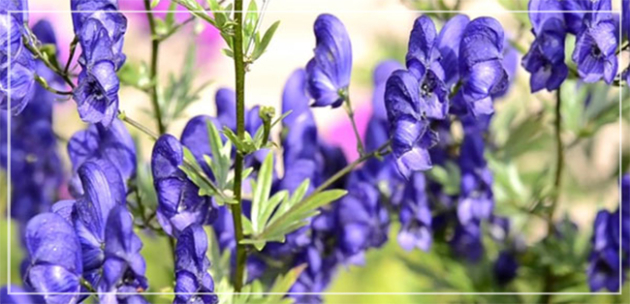
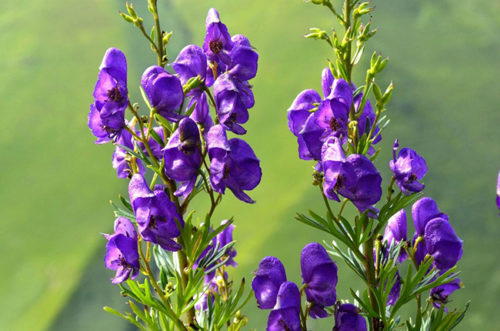
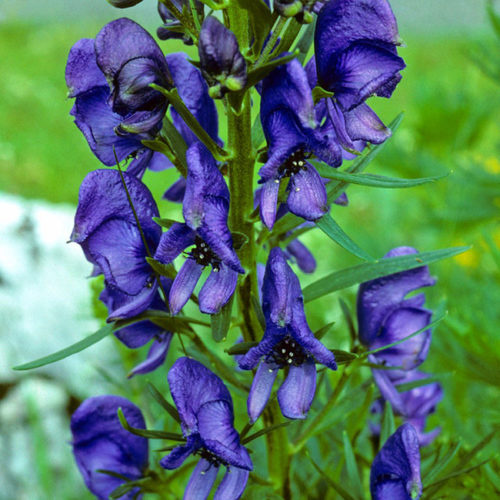
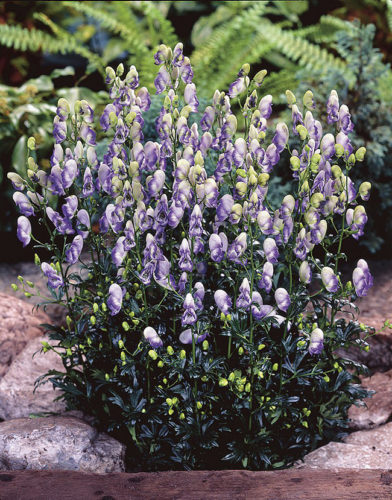

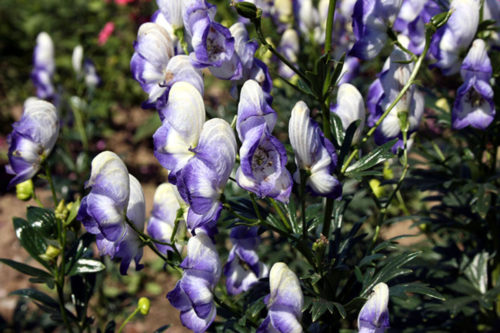
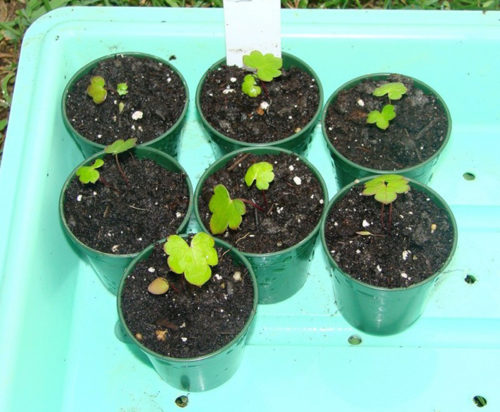
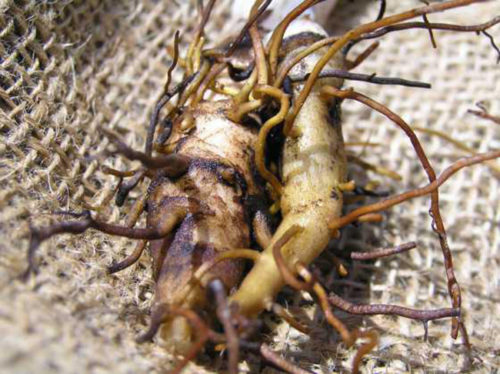


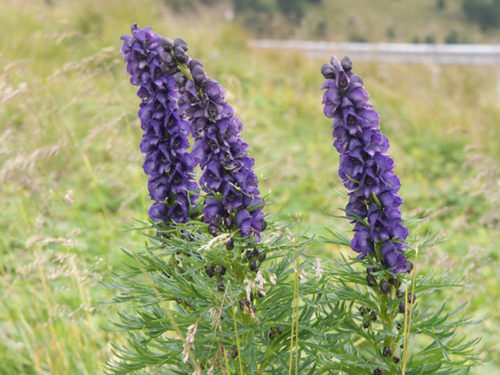
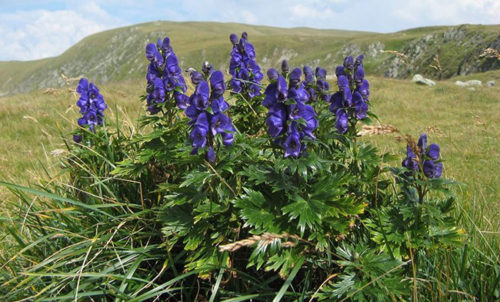
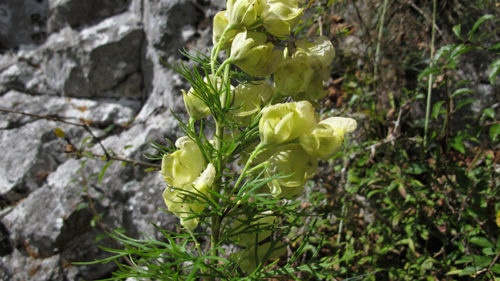
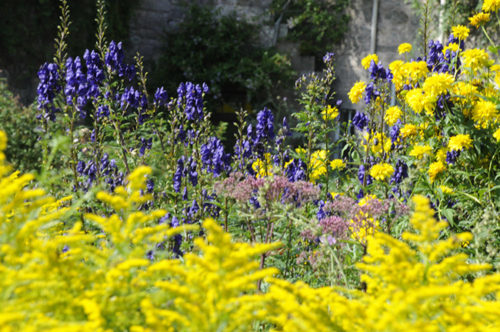
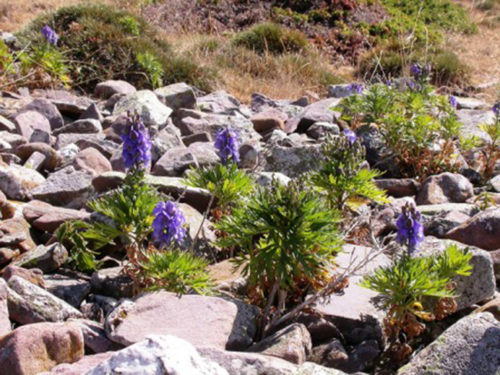
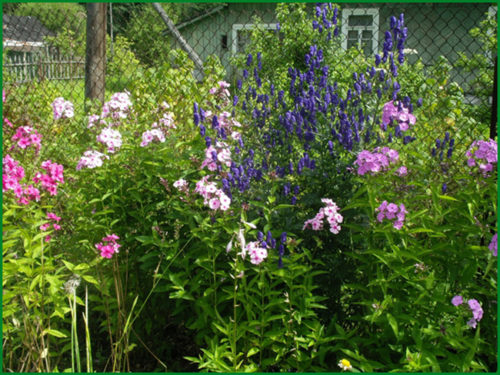












 Start a discussion ...
Start a discussion ...